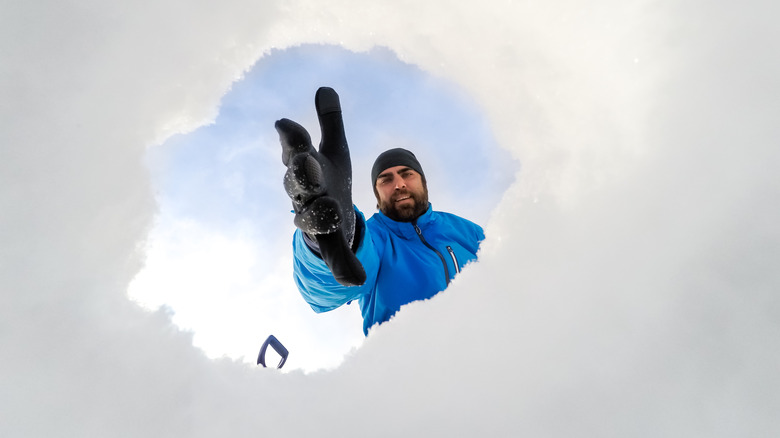The Low-Tech Cold Weather Camping Trick To Keep Your Food From Freezing Overnight
Snow camping can be a challenge, and even seasoned hikers have to adjust to the demands of winter. Snow is often hard to trudge through, which is why so many campers use skis and snowshoes to cross the frozen landscape. Staying warm also requires effort, and winter campers burn more calories than those in warmer weather. If the air gets cold enough, your drinking water can turn to ice inside your bottle and kindling can resist catching fire. You may have a much harder time setting up a tent, and a good snowfall may turn your shelter into a de facto igloo. Mess up, and you could face shivers, head colds, or even hypothermia. However, many outdoorspeople love the challenge, and toughing out a night in a snow-blanketed forest or on a mountainous ice field can be a character-building achievement.
One particular challenge stands out: How do you keep your food from freezing? Any temperature below 32 degrees Fahrenheit can freeze liquids, and certain regions — think of northern New England or the upper Midwest — can drop into negative numbers, which is colder than most freezers. Some foods are invulnerable to cold temperatures, like bricks of ramen noodles or packets of oatmeal, which are both snow camping staples. But what about fresh produce, or even canned food? Winter hikers expend a lot of energy, and eating is especially important; so what stops your food from turning into rock-hard blocks?
One solution sounds counterintuitive: Bury your food in the snow. If you package your items correctly, the snow can actually insulate your food and keep it usable. Just like this low-tech trick to stay warm in your sleeping bag when you're camping in the cold, this simple food storage hack can help you weather frigid overnights.
Storing you food in the snow
In most cases, well-prepared winter campers shouldn't have a problem with frozen food. Your refrigerator probably stores items at 40 degrees Fahrenheit or below, so the temperature outside needs to be brutally cold to cause genuine concerns. Many campers will arrive at their campsite by car — which provides an easy out if you're uncomfortable or need fresh supplies — and the vast majority of campers will spend only one night. While winter outings are on the rise, and there are many awesome spots for snow camping this winter, it's still a niche activity, as snow scares off a lot of people. As a first resort, campers will use fires, hot rocks, or body heat to keep their food from freezing.
But if you do find yourself isolated in nature with dangerously low temperatures and a limited supply of food, here's how you can protect your supplies. First, wrap them in some kind of insulation. This could be a special cooler or bag you've bought for this purpose or a pair of wool socks — anything that retains warmth around the item. Dig a hole in the snow, place your protected food in the hole, and then bury it. As improbable as it sounds, the snow should act like a giant white sweatshirt, preventing heat from escaping. This technique can actually work for humans, as well; survivalists often use "snow caves" to insulate themselves and withstand punishingly low temperatures.
Naturally, you'll want to clearly mark where you've buried your stash, especially if you expect falling snow, which can obscure the terrain. If you need to use this technique, you may consider changing your plans, as these conditions are pretty extreme. Here are 12 more tips for staying safe while traveling in the snow.

